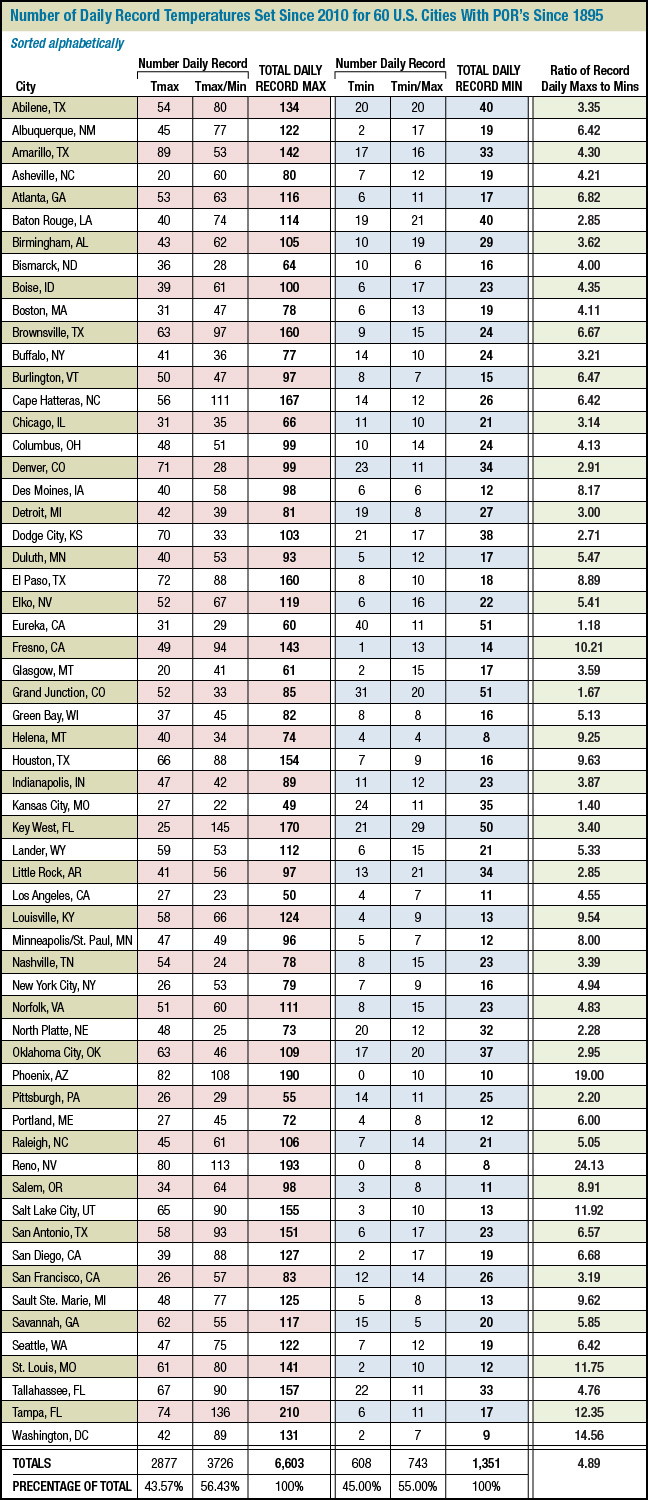| Above: Galveston, TX, one of the oldest cities on the Texas coast. In April, meteorologist and blogger Matt Lanza posted an article on Space City Weather about the unusual streak of record warm temperatures observed in Galveston since 2010 and especially over the past year. From 2010 through April 2017, Galveston tied or set 216 daily record highs or record high minimums out of a possible 732. In other words, almost 30% of all the daily record warm temperatures were set in just the past 7 years. With a period of record going back to 1874 (142 years), this is a remarkable statistic. Image credit: PhilFree/Wikimedia Commons. |
As detailed in the caption above, Galveston, Texas, has set an amazing number of heat records in the last few years. Blogger Matt Lanza (@mattlanza) recently wondered if any other city in the U.S. has broken so many heat records in the same span of time (since 2010). I decided to follow that line of inquiry and researched 60 cities in the contiguous U.S. that have National Weather Service NOWData online records going back to at least 1895. In addition, I looked at six sites in Alaska and Hawaii as well, although only two (Juneau and Honolulu) have periods of record (PORs) dating back to 1895.
Methodology
I chose the 60 towns and cities based on their geographic distribution (more or less evenly spread across all geographic regions of the U.S.) and also for their periods of temperature record going back to at least 1895 in the NOWData files. I also made a point of including some small towns in significant geographical locations such as Cape Hatteras, North Carolina, and Glasgow, Montana, thus minimizing the influence over time from urban heat islands (see below).
 |
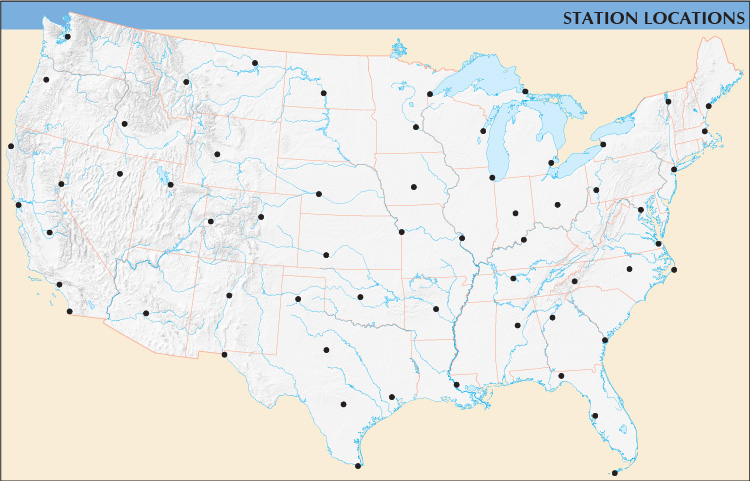 |
| Figures 1 and 2. Sites chosen for this study. Only the locations appear in the bottom map in order to better illustrate their geographic distribution. All of these sites have daily temperature records (in NOWData) going back to at least 1895. |
Although most of these sites have PORs that predate 1895, I used that year (1895-present) as the beginning date for all the temperature record searches, in order that all the sites would have the same PORs (thus comparing apples with apples). Because of the 1895 POR threshold, some major cities could not be included since their NOWData records began at a later point. These include New Orleans (POR 1946-), Charleston (1938-), Las Vegas (1939-), Dallas (1898-), Portland (1940-), and Billings, (1934-). For most of these sites I used other cities in the region that did have data from 1895 as rough surrogates. For instance:
New Orleans, LA => Baton Rouge
Charleston, SC => Savannah
Portland, OR => Salem
Billings, MT => Glasgow
Dallas, TX => Abilene
Unfortunately, there are no sites near Las Vegas, NV, with POR’s from 1895 available to fill this significant regional gap.
After choosing these sites, I used the option in NOWData’s local search tool to search from January 1895 through April 2017 for daily temperature records set on each day of the year:
Tmax: highest temperature recorded on this date
Tmax/Min: highest minimum temperature recorded on this date (typically the warmest nighttime reading)
Tmin: lowest temperature recorded on this date
Tmin/Max: lowest maximum temperature recorded on this date (typically the coldest daytime reading)
Thus, four parameters for daily record temperatures were chosen for this report.
For the 66 sites (60 in the contiguous U.S., plus six in Hawaii and Alaska), a total of around 96,000 data points (66 sites x 366 days x 4 parameters) were perused. I then manually counted how many of the daily temperature records (out of a possible 1464 for each site--366 days x 4 parameters) were recorded from January 2010 through April 2017. I’m sure I may have missed a few records here and there, given that there was no way for me to make the counts in an automated fashion. Nevertheless, the trends in the results remain obvious.
With all the sites having 115 years of data as of 2010, and each year for each site having 1464 possible daily records to break or tie (actually a little less because of leap years), one might assume that each year should break or tie daily temperature records an average of around 12 times per year (6 heat records and 6 cold records) if the climate were in complete equilibrium. Thus, for the period of time since January 2010 through April 2017 (approximately 7.3 years), each site would in theory have broken around 88 daily records (44 cold ones, Tmin and Tmin/max, and 44 warm ones, Tmax and Tmax/min). In fact, the number might be even less, because most of the “easy” records would have been broken long before a century passed. For a more in-depth analysis of how the frequency of records can change over time, see the paper “Relative increase of record high maximum temperatures compared to record low minimum temperatures in the U.S.,” published by Gerald Meehl and colleagues in 2009.
With this in mind, here are the results of my counts in tabular form. Each figure includes the same data for all 60 cities, but sorted in different ways for each figure.
|
| Figure 3. Sorted by city name alphabetically. |
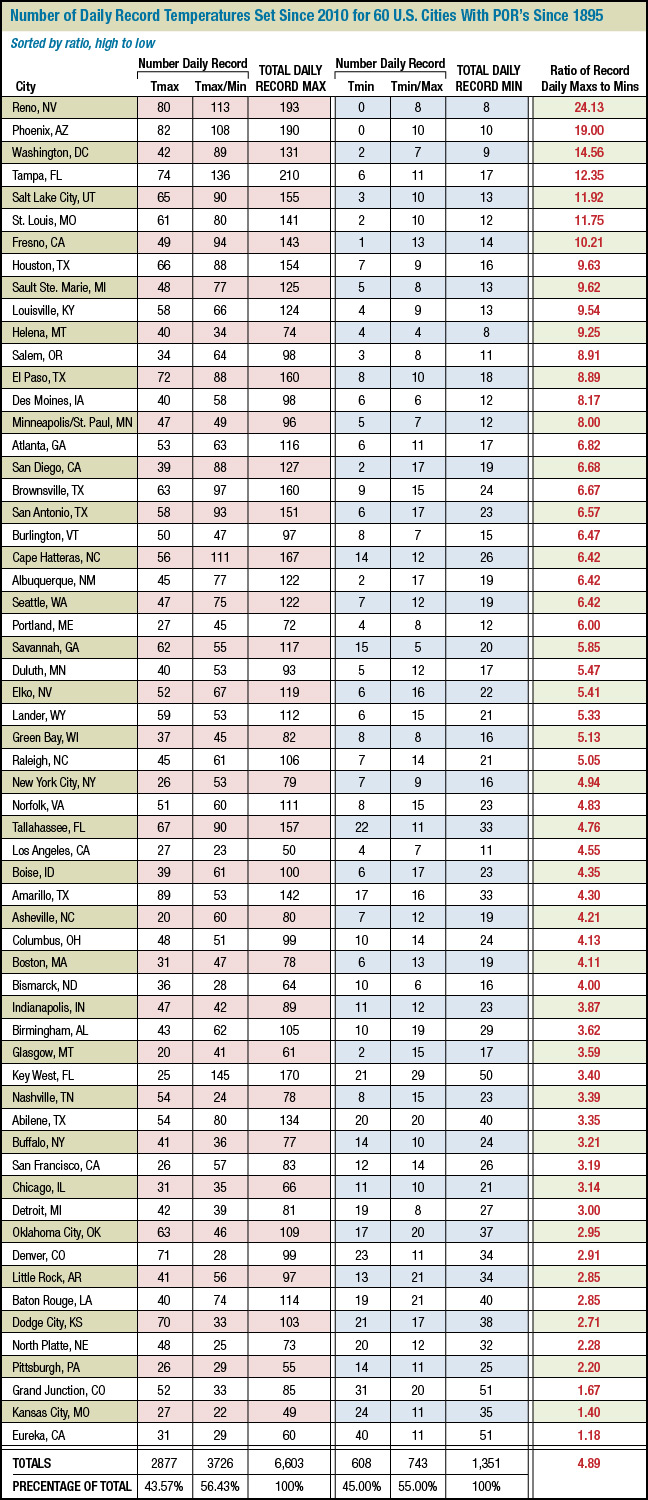 |
| Figure 4. Sorted by ratio of daily heat records over daily cold records (highest ratio to lowest ratio). |
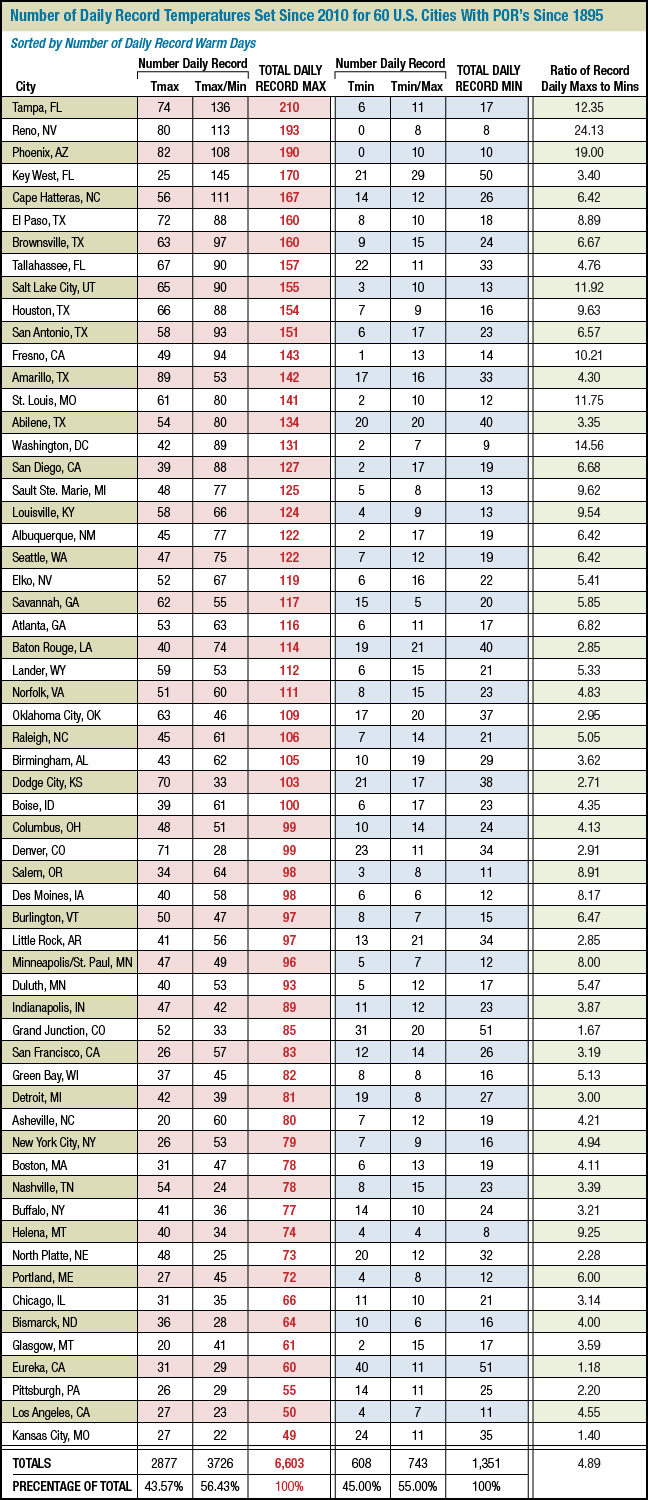 |
| Figure 5. Sorted by most number of days with heat records to fewest number of days with heat records. |
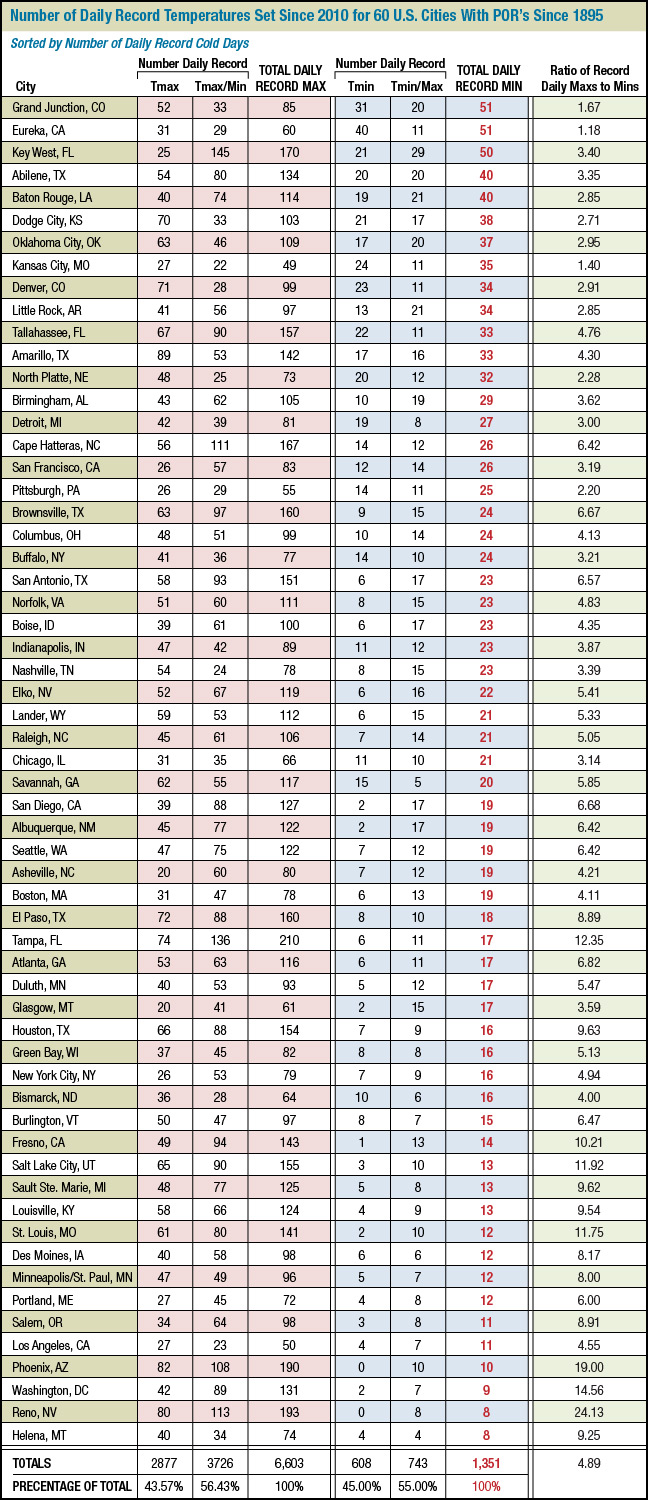 |
| Figure 6. Sorted by most number of days with cold records to fewest number of days with cold records. |
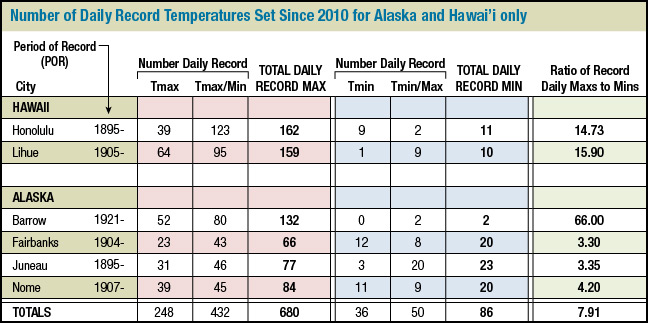 |
| Figure 7. Data for Hawai'i and Alaska. These are not included in the larger tables since only two sites (Juneau and Honolulu) have PORs that date back to 1895. The figures here are just for those curious. Anchorage’s POR is so short in NOW data (since 1953) that it would not be useful to include; likewise for Hilo in Hawaii (with a NOW POR just since 1949). |
Conclusions
• Not a single site recorded more daily cold records than warm ones. Eureka, California came the closest with a heat-over-cold ratio of just 1.18 to 1.00, and Reno, Nevada had the greatest ratio with 24.13 to 1.00 warm records over cold records. The ratio at Reno was much larger than for any other station in my dataset from the contiguous U.S. Barrow, Alaska’s ratio was an astonishing 66.00 to 1.00, although its POR did not begin until 1921. I discussed the increasing warmth at Barrow in a Category 6 post in April.
• The average ratio of warm records over cold records for all 60 contiguous U.S. sites was 4.89 to 1.00 for the period of 2010 to 2017.
• Record warm nights (i.e. Tmax/Mins) were 29.5% more prevalent than record warm days (Tmaxs) and record cold days (Tmin/Maxs) were 22.2% more prevalent than record cold nights (Tmins).
• There was no indication that one region of the U.S. set more temperature records (either warm or cold) than any other region.
• A few sites had not recorded a single daily Tmin (coldest daily minimum) record since 2010. These included Reno, where the last Tmin record was set in 2004; Phoenix (last daily Tmin set in 2008); and Barrow (last daily Tmin set in 2007).
• Tampa, Florida recorded the most daily warm records (Tmax or Tmax/min) of any site researched, with 210 such days. This is just short of Galveston’s 216, so Matt Lanza may be correct in his hypothesis that Galveston has measured more daily heat records than any other first-order NWS site in the U.S. with a POR going back to at least 1895.
Issues with the data for some locations
The urban heat island effect has most likely had a profound effect on the daily temperature record regimes for a few sites such as Phoenix. Furthermore, the location of the instruments in most of the cities researched has moved at least once (if not more often) over the course of the past 122 years. In some cases, like Denver, NWS offices have moved from locations near downtown to new locations farther from the urban core (onto the High Plains in the case of Denver). On the other hand, observations have been collected from the airport in Reno, Nevada, since 1931, but this formerly rural location is now surrounded by urban development, as explained in a document from the local NWS office.
The readings from Kansas City are curious in that only 49 record daily warm temperatures (both Tmax and Tmax/Min) have been observed (with a very low ratio of heat over cold records of just 1.40 to 1.00). This is in sharp contrast to St. Louis with an 11.75 ratio or Des Moines with an 8.17 ratio, the two sites closest to Kansas City among those researched.
Regardless of the above issues, the urban heat island or location change alone cannot account for the overall picture of a dramatic increase in record daily high temperatures relative to record daily low temperatures over the course of the past seven years.
Note: Meteorologist Guy Walton has been tracking daily temperature records for the entire U.S. for a number of years now, using NOAA data. Guy updates the results every month on his website “Guy on Climate.”
KUDOS: Many thanks to Mark Stroud of Moon Street Cartography for the map and table productions.
Christopher C. Burt, Weather Historian

